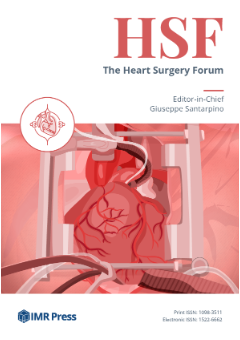Announcements
The Heart Surgery Forum (HSF) is published by IMR Press from Volume 28 Issue 9 (2025). Previous articles were published by another publisher under the CC-BY-NC licence, and they are hosted by IMR Press on imrpress.com as a courtesy and upon agreement.
Open Access
Article
MIDCAB: Impact of Epicardial Stabilization Upon Outcomes
E. Charles Douville1, John R. Handy, Jr1, Andrew C. Tsen1, Gary Y. Ott1, Mark Gilbert1, James W. Asaph1
Show Less
Affiliation
1
The Oregon Clinic and Providence Portland Medical Center, Portland, OR, USA
Heart Surg. Forum 1999, 2(1),
41–46;
Published:
1 March 1999
Abstract
Background: Minimally invasive direct coronary artery bypass (MIDCAB) has been criticized as compromising anastomotic patency. Epicardial mechanical stabilization devices purportedly facilitate left internal mammary artery (LIMA) anastomosis, thereby enhancing patency and outcome.Methods: From June 1996 through January 1999, 39 patients underwent MIDCAB via a small left anterior thoracotomy for revascularization of the left anterior descending coronary artery (LAD) without cardiopulmonary bypass (CPB). Immediate postoperative coro n a ry angiography was performed on 38 of the patients.Results: Group 1 consisted of 11 patients who were operated upon without epicardial stabilization. Mean age was 64 years. Two had undergone previous coronary artery bypass (CAB). Predicted mortality was 4.3%. Angiographic anastomotic patency was 60%. Revisions on CPB in three cases increased LIMA patency to 90%. There was one intra-operative death. Average length of stay (LOS) was 5.4 days. Group 2 consisted of 28 patients operated on with mechanical epicardial stabilization. Predicted risk of mortality was 4.4%. Mean age was 66 years. Twelve had undergone previous CAB. Anastomotic patency at angiography was 97.4%. There were no intra-operative deaths and mean LOS was 3.0 days.Conclusions: We conclude that mechanical epicardial stabilization has transformed the MIDCAB operation into one that offers excellent early patency and clinical outcomes. This operation is of particular value for revascularization of the anterior coronary circulation in patients with previous CAB; clinical results are significantly better than predicted for standard redo-CAB.

